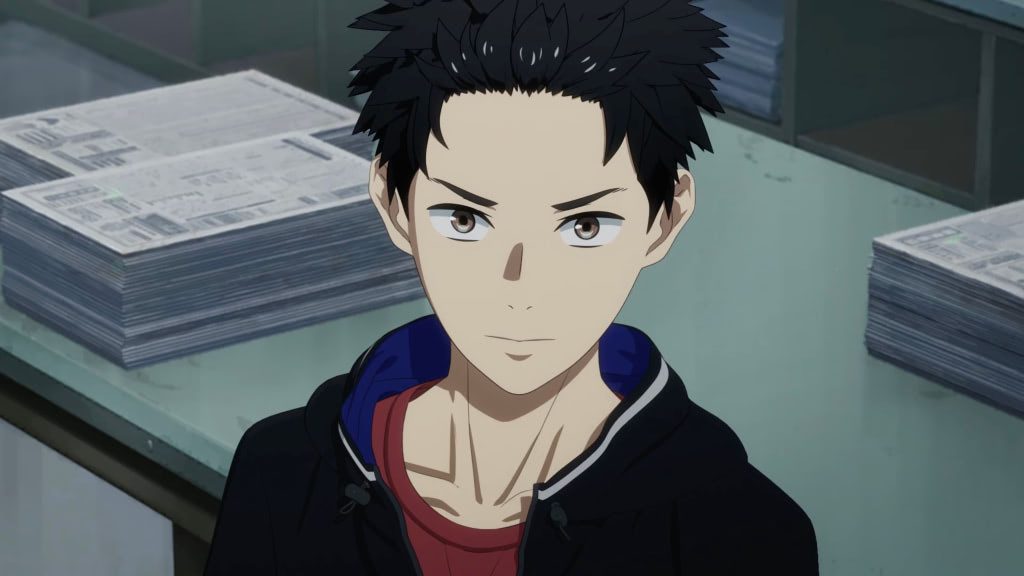Eternal 831
June 26, 2023 · 0 comments
By Shelley Pallis.

Suzushiro might seem a little bit old to be doing a paper round, but he’s a college student on a “newspaper scholarship” who needs the money. Well, everybody needs the money – Japan is on the skids after an “unprecedented disaster”, that might be covid-19, or might be whatever the next jackpot of misery is. Things have taken such a turn for the worse that (wait for it), there’s even a woman standing in as prime minister – a sly dig at the late Shinzo Abe’s “womenomics” policy, which only seemed to hand power to the ladies when there was just about to be a scandal that someone would need to resign over.
But Suzushiro has a secret – a super-power that he wishes he had never acquired: the ability to stop time. And as he tries to wheel and deal his way in Tokyo’s increasingly stagnating society, he comes to realise that there are others who have the same sort of power, and that they are putting it to far more explosive use.
Eternal 831 is an angry film, an embittered snarl from Generation Z, directed at the older generation that’s got them into this mess. We get to see Suzushiro’s simmering resentment as he tries to get subscription payments from customers determined to scam him, every one of them a representative, in their own way, of the generation that bumped up global warming, shorted on their mortgages, and coughed on each other in the middle of a pandemic. In that regard, there is an element here of Makoto Shinkai’s controversial ending to Weathering with You, which similarly addresses the concerns of a lost generation with little hope of saving the world.
Every one? No, not every one – there’s a little old lady who insists on meeting him in the street and paying him on the spot, a little analogue throwback like the matriarch of Mamoru Hosoda’s Summer Wars, reminding the viewer that even the little things can make a big difference.

Such a philosophy, however, cuts both ways. Kamiyama’s self-penned script takes the psionic super-powered kids of the 1970s sci-fi boom and wonders what the world would be like if they found themselves stuck in the middle of a hopeless situation. He imagines an anarchist group with the convenient ability to stop time in order to get all their plans into action
In interviews, Kamiyama has said that part of the inspiration derived from a sense of how little Japanese youth have to look forward to. After twenty years of “stagflation” and a decade of an economy struggling to drag itself out of the damage done by the 2011 tsunami, Japanese teens, like teens the world over, have been hit by a two-year pandemic. Why not live each day as if it the last day of a summer vacation? Why not “liberate” money or opportunities that have been effectively left dormant, or – the movie’s term – “stopped” by circumstances beyond their control?
“It became obvious to anyone,” he told Animage, “that the Japanese economy was at a standstill. Even so, I was wondering if I could somehow express the situation in Japan, which is unable to move forward, through the psychological state of the main character, who has the ability to ‘stop time’.
The title derives from the date, 31st August, at which Kamiyama felt an overwhelming sense that he was almost like a kid on the eve of going back to school, who hadn’t yet bothered to do any of the homework tasks he had been set for the summer. “It’s not just August 31st, I’m looking forward to August 31st with an indescribable feeling that I haven’t finished my homework. It is said that there is both a very unpleasant feeling that it continues for a long time and a certain kind of pleasure. That’s why when I thought that it might not be possible to move forward, I thought that it might be expressing something that everyone has latent thoughts but can’t quite put into words, so I chose this title.”
You can see, from the very opening scenes, the tell-tale micro-movements that give away the fact that the animation on screen might be better described as motion-capture, and that this is a film that might be better filed with The Case of Hana & Alice, as a “live” film augmented with copious animations and effects. But there is also a strong sense of covid-era film-making, particularly in the multiple shots of empty streets, which, one suspects are much easier to digitise when everybody is locked away indoors hiding from a global pandemic.
“Craftar is a studio that has pursued that kind of cel-look animation ever since they founded the company,” says Kamiyama. “It’s not tied to the animator’s skill, so I think there’s a joy in the animation itself when you apply a cel-look to it, even if it’s still 3D.”
“I want people of the same generation as the main character, Suzushiro, to see it, but I also want people from my generation, who feel numb, who are giving up in a sense, I want them to see it, too, and wonder if they really should jack it in just yet. I think people will react to it in different ways depending on which generation they come from, and I can’t wait to hear what their impressions are.”
Eternal 831 is released in the UK by Anime Limited.
Leave a Reply